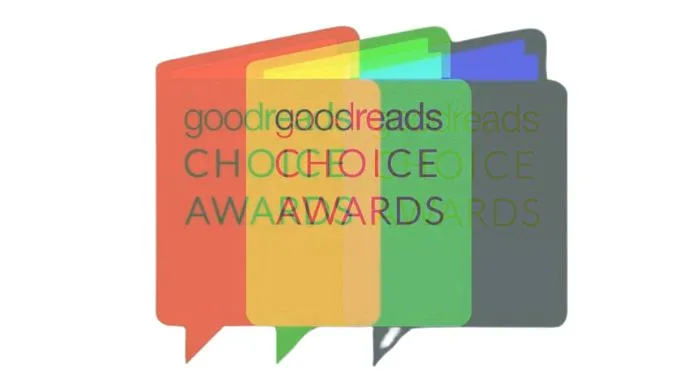
The Unbearable Whiteness of the Goodreads Choice Awards
The 2024 Goodreads Choice Awards broke records. The site, which is owned by Amazon and boasts over 150 million members globally, saw 6.2 million of those members vote in the annual reader’s choice awards. That may seem but a small percentage of the full user base of the site, but there is not clear data on how many of the 150 million members are active and engaged. For perspective, about 152 million Americans voted in the 2024 presidential election of the 245 million eligible voters.
Goodreads’s largest traffic source and use comes from the United States. A whopping 48% of users are in the US, with the United Kingdom (7%), Canada (6%), Australia (4%), and India (3%) rounding out the top six. Goodreads has more female-identifying users than male, at about 60% to 40%. Demographically, the site’s users swing younger, with those between 25 and 34 accounting for about 30% of total users. This is followed by those between 18 and 24 at 21% and those between 35 and 44 at 18%*. If you’ve got a book that’s going to reach a young female readership, Goodreads is an excellent place to be.
But Goodreads has a problem. The platform is dominated by white users and as a result, the Goodreads Choice Awards reflect back a whiteness that is not only unrepresentative of the year in publishing but fails to acknowledge a decade’s worth of work on increasing the visibility of diversity throughout the book world.
As with any private company, particularly one housed under a giant organization like Amazon, finding the demographics of Goodreads’s user base is difficult. Per Quantcast data from 2020, though, we have some idea of the primary racial identities of its users. Goodreads users are 77% Caucasian, 9% Hispanic, 7% African American, 6% Asian, and 1% other. In other words, just over 7.5 out of every 10 users on the site are white. In 2022, the United States as a whole had roughly 59% of its population identified as white.
It is impossible not to see the site’s whiteness, as well as the continued challenges to encourage diverse reading, pushes to better fund marketing and publicity campaigns for diverse authors, and the ways in which Goodreads has altered book discovery to the average reader through its proprietary algorithm and pay-to-play giveaway and promotions site-wide.
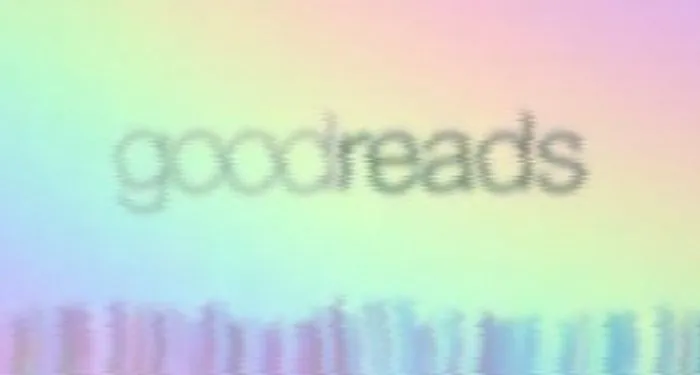
The Goodreads Choice Awards launched in 2009. A humble offering, the first awards for the book site have yet to even be stylized like later iterations of the award. These readers’ choice awards did not appear in December as they have in more recent years; they were shared in early January 2010. Awards creep, seen not only on Goodreads but at media outlets more broadly, had not yet made it a race to see who could name their best books first.
That first year for the Choice Awards saw a total of 13 categories, ranging from All Time Favorite book to Fiction; Picture Book; Chick Lit, which came with controversy over what that term meant and what titles would even be eligible; Romance; YA series; and more.
2009 was a year for the men in the Choice Awards. Of the 15 authors who had books earn the honor, nine were men. There were zero books by authors of color that year.
The first year for any project is tough. It’s when you’re testing the waters and seeing if the thing will even land. For Goodreads, it did, and in 2010, the Choice Awards were back with even more categories and participation.
Three categories were eliminated in 2010: All Time Favorite, Chick Lit, and YA Series. They were replaced by several new categories, including Paranormal Fantasy, Historical Fiction, Humor, Memoir and Autobiography, Poetry, YA Fantasy, Debut Author, Goodreads Author (as in, an author who has an official presence on the site), Favorite Heroine, Favorite Hero, and Cover Art. That brought the number up to 23 Choice Award categories in the project’s second year.
With the increase in categories came, too, the increase in better representation of gender. There were 16 female authors and 9 male authors. Diversity, on the other hand, only increased marginally: a whopping one author in 2010 earned a Choice Award.
Still feeling their way around such a huge project with tremendous response, the Choice Awards were back in 2011 with 22 categories. Gone were Debut Author, Favorite Heroine, Favorite Hero, and Cover Art. 2011 became the year readers could first select their favorite Horror book (a mood, not a genre, as is well-reflected in the winners), Food and Cookbook, and Travel and Outdoors.
Alas, 2011 was not the year for authors of color. Zero appeared as Choice Award winners. Women made up a total of 15 authors, while 10 men had their work represented.
As will become clear soon, the first years of the award involved a lot of tweaking and tinkering with categories. By 2012, the Goodreads Choice Awards landed at a nice round 20 categories. In that year, Travel and Outdoors, as well as Favorite Book of the Year were eliminated from the ballot. There were still no authors of color represented among the 20 categories. There were 13 female authors and 10 male authors.
2013 brought yet another small change. This was the year that “Goodreads Author” changed to “Debut Goodreads Author,” to honor authors who were Goodreads users but had published their first novel. It was also a big year, as within the 20 categories, three authors of color were among the winners. In terms of gender, there was near parity, with 12 women and 11 men represented.
During those first five years of the Goodreads Choice Awards, winners were extremely white. As in, a whopping four authors of color were honored out of the entire batch of winners those years. You can see what that looks like in the charts below.
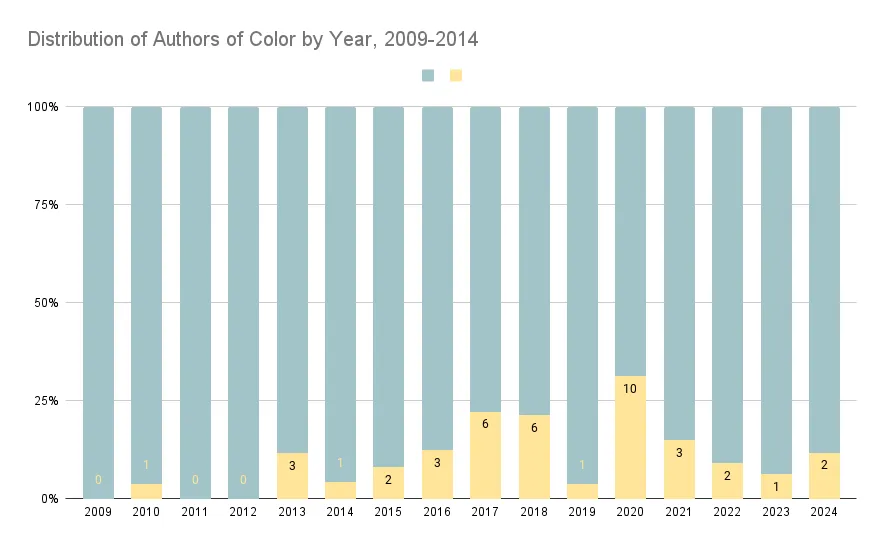
It looks bad enough in bar chart form, but when you look at the number of authors of color who make up the percentage of the whole first five years of the Choice Awards, it is even more stark. Fewer than 4% of the winners were writers of color.

As for the breakdown in genders, every year in the first five except for the first, 2009, saw more female authors represented than male.
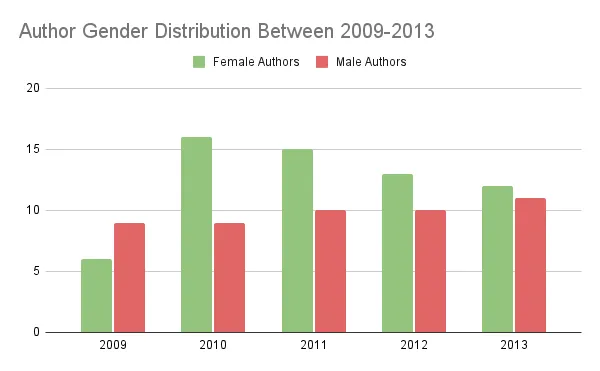
And overall, 62 of the 111 total authors were women, representing a little over 55% of the total authorship.
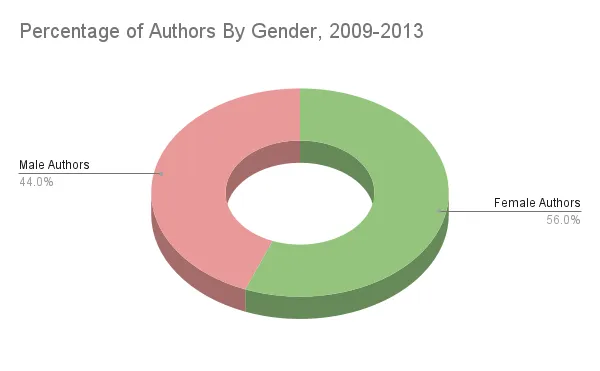
Despite being the predominant gender of authorship, women saw zero representation in several of the Choice Award categories between 2009 and 2013. Those categories are surprising, too. For all of the talk of women “dominating” books for young readers during that era of online book conversation—a conversation still pervasive in the narrative and ascribed to everything from there being no books “for books” and worse, that it’s part of why boys don’t even read—absolutely no women saw picture books nor middle grade Choice Award wins in those years.
Readers really love their young people’s literature by men and they especially love those books when they’re by men who are celebrities or who have earned massive audiences in the adult literary world.

It would not be until the year 2022 when Rick Riordan did not have a Choice Award winner in the Middle Grade & Children’s Category, and it is probably only the case he did not in that year because Picture Books as a category were removed and folded into Middle Grade & Children’s. The 2022 winner was a picture book, I Am Quiet by Andie Powers and Betsy Petersen.
By 2023, the category for Middle Grade & Children’s was gone entirely. Not a single writer of color won that category from the time of its inception in 2009 until its sunset 14 years later. Andie Powers and illustrator Besty Petersen were the only female-identifying winners over the course of the category.
Taking a pause between the Goodreads Choice Awards during its first five years and its next 10 is important. The year 2014 was a massive one in the book world, particularly when it came to reckoning with the whiteness of the industry. We Need Diverse Books (WNDB) launched in 2014, in response to report after report of how few books by and about people of color were publishing; this was ignited in part thanks to Book Expo America’s failure to include any authors of color as their major draws to the event (in 2014, Grumpy Cat was lauded as a celebrity at Book Expo, marking more cats than people of color in the line up).
WNDB made waves throughout publishing, and in response, many bloggers, writers, authors, libraries, schools, and the industry itself turned toward the mirror to make conscious change. Of course, it wasn’t going to be industry-wide change, as systems built upon oppression and white supremacy cannot dismantle themselves through the same tools that built them. But WNDB was—and is—uniquely situated to continue demanding (and cheering!) change.
Unlike in 2020, when Black Lives Matter steered the course of the general public’s book-buying habits—at least for a couple of weeks—the sea change with We Need Diverse Books was not as broad or deep in those first years. It was a powerful start, but as the Goodreads Choice Awards for 2014 and forward show, when your primary user base on a website is white and the books marketed to them are by and about white people like them, that will be reflected back in the books that demographic believes are the best of the year.
The 2014 Choice Awards saw the end of Paranormal Romance and the addition of Business Books. It was the era of the #GirlBoss after all, and fittingly, it was #Girlboss that won the category in its inaugural year. Of the 20 categories in the 2014 Choice Awards, one author of color was honored, while 13 female authors sat alongside 9 male author winners.
One year later, in 2015, the era of the #GirlBoss was gone and so, too, was the Business category of Choice Winners. It is quite likely the decision was less about the book trends and more about the user base of Goodreads. That category was swapped for Science & Technology instead. To remember 2015, for those who might be trying to recollect what was going on in that period, the winner of the Fiction category was Harper Lee’s “discovered” novel Go Set a Watchman. We saw two authors of color win awards, both of whom had been on a long-running, beloved sitcom that went off the air in 2013: Mindy Kaling and Aziz Ansari. Twelve female authors and 11 male authors made the cut that year.
2016 and 2017 saw zero categories added or eliminated. Of authors honored in each of the 20 categories, there were 3 authors of color in 2016, alongside 10 female and 11 male authors. In 2017, six authors of color were honored, as well as 17 female authors and 4 male authors.
One-quarter of the authors in the 2017 Choice Awards were people of color. This number was still below the percentage of those in the United States who identified as people of color—between 35-40%—but it represented a massive leap in these awards. What made 2017 different? A good part of it was the efforts of WNDB, of course—The Hate U Give by Angie Thomas published that year, garnering significant acclaim and readership, thanks to the efforts of the publisher to put time, money, and energy behind a book by a Black author. The fact the book went to a 13-house auction prepublication started the buzz early and the effort paid off. For the Choice Awards, Thomas won in two categories, Debut Goodreads Author and YA Fiction.
But there was more going on in 2017. It was the year of the Charlottesville Unite the Right rally. This white supremacist rally led to weeks-long efforts by the administration to color these white boys as anything other than domestic terrorists while simultaneously, white people reckoned with shock to see such open racism and bigotry. Though Charlottesville wouldn’t lead to the same surge in book sales as the George Floyd and Black Lives Matter protests in 2020, the impact was felt.
To be clear, The Hate U Give is a phenomenal book. But it did a lot of work for the Goodreads Choice Awards not only in 2017, but then again in 2018. Goodreads added a new category that year simply called The Best of The Best. The winner? The Hate U Give. That helped 2018 showcase 6 authors of color across its 21 categories. That year saw 17 women and 8 men honored.
Just one year later, the Best of the Best category was eliminated.
So, too, was the rise of the author of color in the Goodreads Choice Awards.
2019 saw but one author of color honored—again, a celebrity, Ali Wong—while 14 women and 8 men were honored. What 2019 did do in the Choice Awards was offer more gender diversity. Three of the winning books were written by nonbinary authors. It was the first time any author outside the gender binary won. Of those three titles, one author, Casey McQuiston, was honored with two Choice Awards. The other author was celebrity Jonathan Van Ness who came out as nonbinary that year.
This would be the first and, for now, the last time authors outside the binary would win the Choice Award.
At the same time that people were locked down at home with COVID-19, the face of the Goodreads Choice Awards changed in 2020. It was the year of authors of color, and it was the year of Black authors in particular. Nearly one full half—10, to be specific—of the 22 authors on the list were authors of color. Two of those were Ibram X. Kendi, as his books about antiracism landed at the top of both the Nonfiction and Picture Book categories. Titles by Barack Obama and Isabel Wilkerson were found on the Memoir and Autobiography and History and Biography lists respectively.
2020 was the year of buying books about antiracism. In May and June, people in the US were purchasing titles primarily by Black authors about racism and the history of US racism, spurred by the George Floyd and Black Lives Matter protests. Antiracism books were selling out, and many questioned whether this time, we’d finally see true change in America when it comes to race. Others wondered whether or not it was purely performative—something that we got the answer to on November 5, 2024.
Intentional or not, there was a strange response from Goodreads following the 2020 Choice Awards. 2021 saw three categories eliminated: Food and Cookbooks, Picture Books, and Science and Technology. Now down to 17 categories, three authors of colors walked away with Choice Awards, while 12 women and 5 men did. The slim 17 categories continued in 2022, which saw only two authors of color win, alongside 17 women and three men.
More cuts came to categories in 2023. Gone now were Middle Grade & Children’s, Comics and Graphic Novels, and Poetry. But one category was added, which was Romantasy. As the number of possible Choice Winners decreased, so, too, did the number of authors of color. 2023 saw 1 author of color represented, while 10 female and five male authors were honored.
As we reach 2024, now 16 years from the start of the Choice Awards and 10 years from the start of We Need Diverse Books, it is hard not to look at the Awards with more questions to be asked than answers to be had. With the elimination of the entire category of comics in 2023, the YA fiction category became the default for comics fans—Alice Oseman’s Heartstopper, Volume 5 took the win there, which means no novel won the category that has always featured a novel. 2024 saw the elimination of the humor category, but the addition of an audiobook category. That new category brings with it something positive because it acknowledges the growth of listening to books, but this year’s winner won in another category. In other words, books that are popular within a genre, such as this year’s Funny Story by Emily Henry, now have another category they can win.
In 2024, there were only two authors of color represented on the Choice Awards. There were 11 female authors and 4 male authors included.
Taking a step back now, what does diversity look like throughout the course of Goodreads’s 16 years of the Choice Awards?
Not great.

Just over 11% of the total number of authors who have won a Goodreads Choice Award are authors of color. That is a paltry fraction of the number of people of color in the US—again, the primary user base of Goodreads—let alone a fraction of the people of color globally.
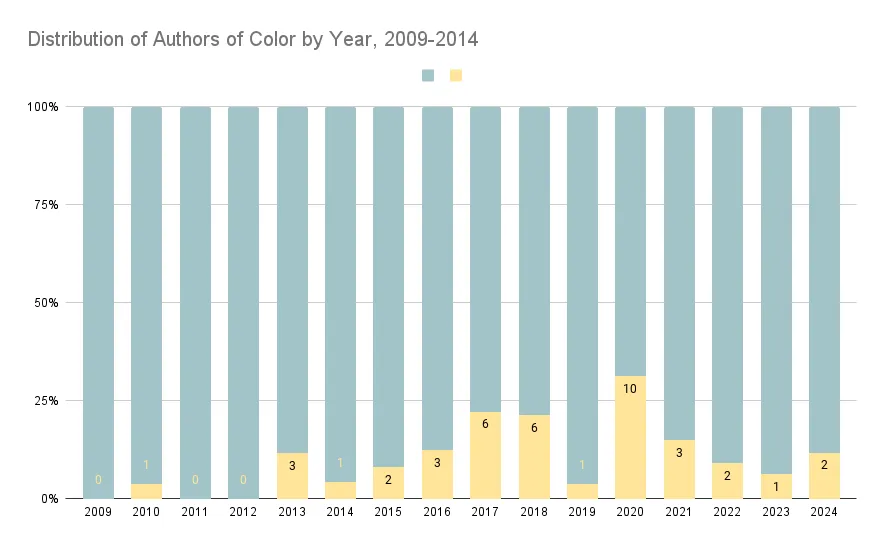
Since 2020, when there were 10 authors of color represented across the 20 Choice Award categories, the number of authors of color getting honored with such an award has dropped significantly. Also dropping significantly during that time? The number of categories, period.
Category editing on the site showcases the editors’ attention to trends and popularity, as we saw the rise of Paranormal Romance through several Choice Award cycles, but it was soon eliminated. In its place came Romantasy in 2023 and 2024. It is fascinating to see the themes and styles of books that landed in the categories which have been there since the beginning. Dark contemporary romances dominated the Choice Award winners in the earlier years, but by the 2020s, the covers were primarily illustrated and in brighter, lighter, more rom-comy signaled titles.
But with these trends that respond to reader (and publishing) interests (and money), so, too, came Goodreads Choice Awards eliminating long-running, staple categories of comics, poetry, and humor. These were all categories where authors of color were previously represented and in some cases, quite well. With fewer categories and more books vying for them, as frustrating as it is to see such a backslide, it’s also far from surprising.
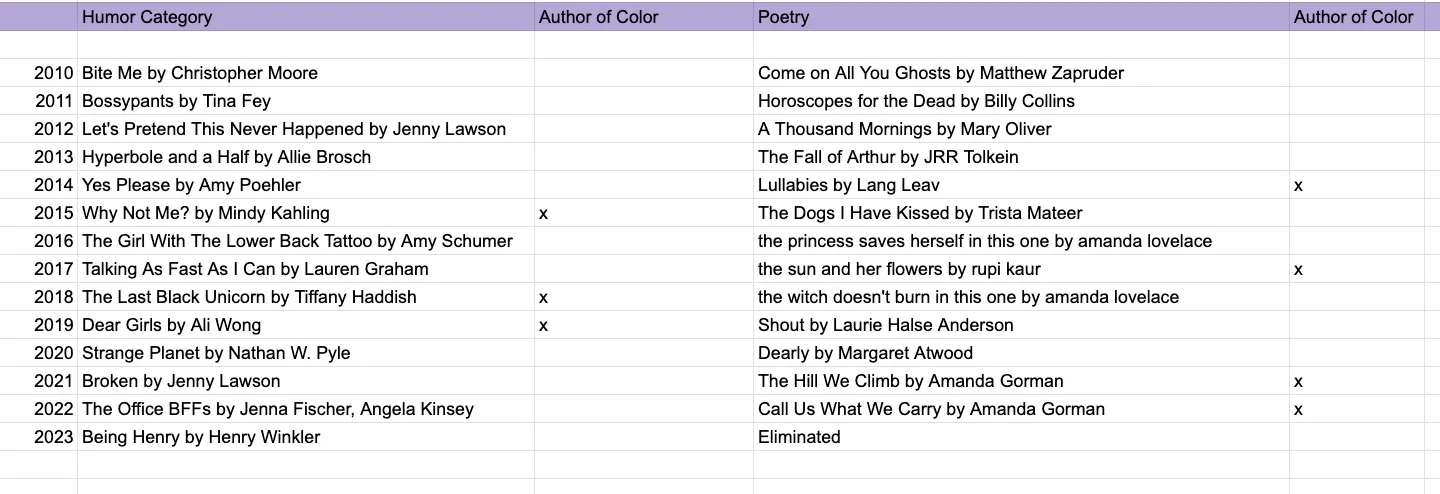
As far as gender, Goodreads Choice Awards both reflect the population and their own user base. The platform, though, could better represent trans and nonbinary authors in their winners, as the high mark in 2019 has yet to be replicated, despite better gender diversity in books and publishing more broadly (though perhaps that is something worth questioning in and of itself—are there more books by authors outside the binary or are outlets beyond Goodreads, The New York Times, and other legacy media better at promoting and highlighting the titles that are available?).
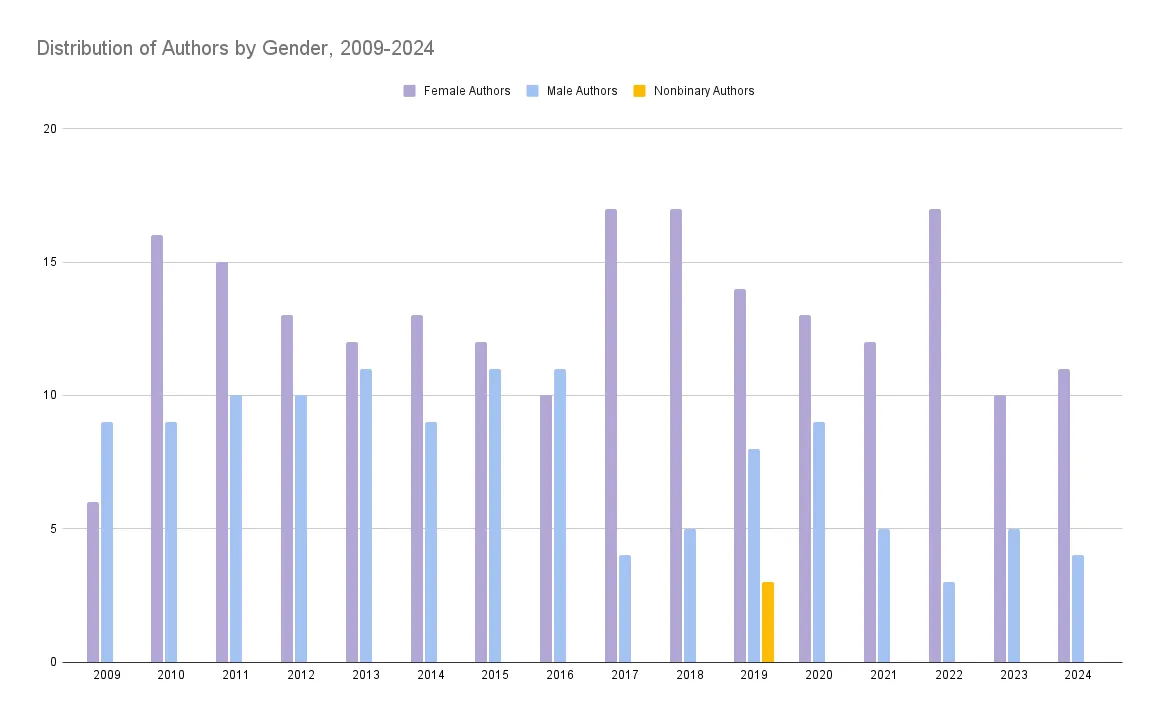
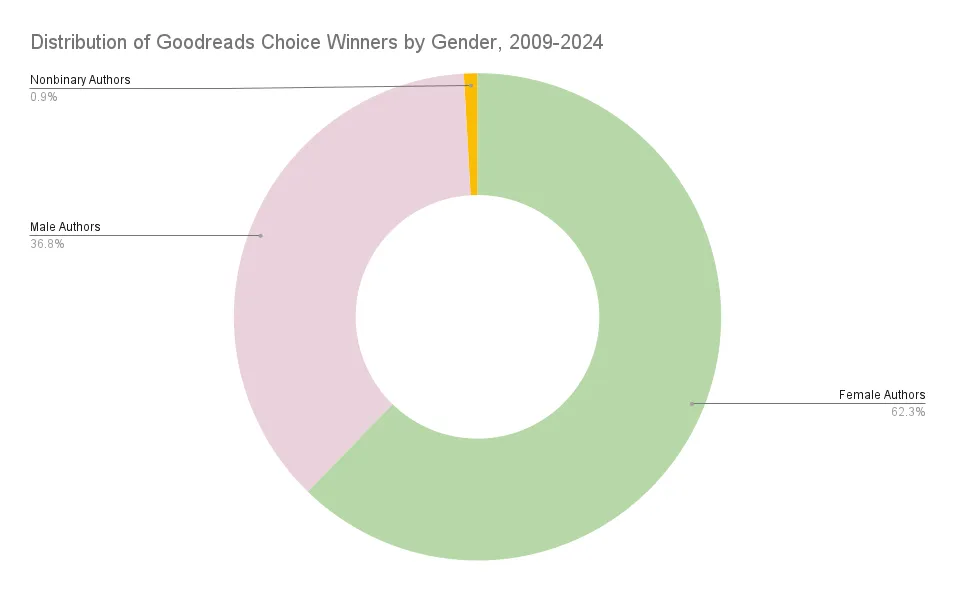
Goodreads sits at the unique intersection of social network and marketing platform. Throughout the Goodreads Choice Awards years, we’ve seen that Goodreads has used it as an opportunity to promote the site as a place for authors to be to share their work—see those “Goodreads Author” cum “Debut Goodreads Author” categories that popped up. For the bulk of Goodreads’s lifespan, it made sense for authors to engage. They could talk directly to readers while also sharing the books they’ve been reading, chat it up on message board forums, and even give away copies of their books. That last point is important: the giveaways sparked a lot of engagement on the site and helped put new books on the radars of Goodreads users. It can be hard for hardcore book people to remember, but most readers on the site aren’t of the diehard variety, so these giveaways can be the first time they discover an author who might be garnering buzz in various corners of the book world.
In 2018, though, Goodreads changed what used to be a strong place for publicity and marketing for the average (read: midlist) author. It would begin to charge for their giveaway feature, even though Goodreads itself had no part in the acquisition or distribution of prizes. It simply provided the platform.
That change was a big deal, since now that would be built into the cost of a marketing or publicity budget. And when it comes to marketing and publicity, the platform and outlet matter. If your platform is, like the case with Goodreads, primarily white women between the ages of 25 and 24 living in the United States, then those books are going to be the ones most likely to appear in advertising and giveaways across site.
Should we be surprised that the winners of the Goodreads Choice Awards represent the very demographics that populate the site? No, probably not. But we can and should hope that after 10 years of efforts to ensure that diverse books are getting the time, energy, and attention they deserve, as well as efforts throughout the industry to better reflect the demographic makeup of the country (and world), the needle would move.
And sure, we’ve seen it move. But only when it was convenient and tied to outright violence experienced by people of color.
What of the smaller violences happening every single year as these lists come out and it’s again title after title by white people, even when the larger scope of books out that year is inching closer to actually representing the world as it is?
It’s 2024, and we still can’t muster to put more than two authors of color on a Readers Choice list, and that embarrassment still comprises one of the stronger showings of authors of color for such a list historically.
*This data is from SimilarWeb as of November 2024. The information here may differ on other web traffic data sites, but this aligns pretty strongly with the information presented by other media outlets when reporting on Goodreads over the last several years.











